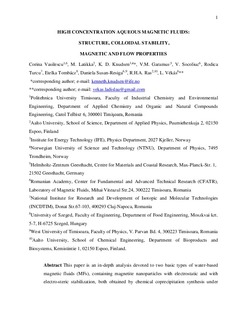| dc.description.abstract | This paper is an in-depth analysis devoted to two basic types of water based magnetic fluids (MFs), containing magnetite nanoparticles with electrostatic and with electro-steric stabilization, both obtained by chemical coprecipitation synthesis under atmospheric conditions. The two sets of magnetic fluid samples, one with citric acid (MF/CA) and the other with oleic acid (MF/OA) coated magnetic nanoparticles, respectively, achieved saturation magnetization values of 78.20 kA m−1 for the electrostatically and 48.73 kA m−1 for the electro-sterically stabilized aqueous ferrofluids which are among the highest reported to date. A comprehensive comparative analysis combining electron microscopy, X-ray photoelectron spectroscopy, attenuated total reflectance Fourier transform infrared spectroscopy, vibrating sample magnetometry, small-angle X-ray and neutron scattering, dynamic light scattering and magneto-rheometry revealed similarities and essential differences on the microscopic and macroscopic level between the two kinds of water-based ferrofluids. While the saturation magnetization values are quite different, the hydrodynamic volume fractions of the highest concentration MF/CA and MF/OA samples are practically the same, due to the significantly different thicknesses of the particles’ coating layers. The results of volume fraction dependent structure analyses over a large concentration range by small-angle X-ray and neutron scattering, correlated with magneto-rheological investigations for the electrostatically stabilized MFs, demonstrate formation of short chains of magnetic nanoparticles which are relatively stable against coagulation with increasing concentration, while for MFs with electro-steric stabilization, magnetic field and shear rate dependent loosely bound structures are observed. These particle structures in MF/OA samples manifest themselves already at low volume fraction values, which can be attributed mainly to magnetic interactions of larger size particles, besides non-magnetic interactions mediated by excess surfactant. | nb_NO |
